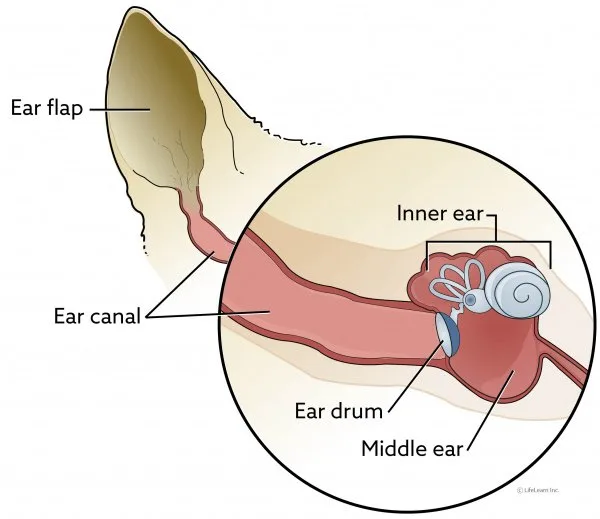Getting the news that our beloved dog has any kind of illness is devastating. Learning that your dog has Vestibular disease is a shock we don’t want anyone to experience. But, what to do when your vet tells you this? Well, the first thing you will have to learn is how to feed a dog with Vestibular disease.
Vestibular disease is a condition we as dog owners need to take very seriously. We need to learn and educate ourselves about the disease itself and how to deal with it. More importantly, we need to learn how to help our dogs that suffer from this disease.
In this article, we are going to learn a little bit more about Vestibular disease, and how to be there for your dog with it. Most importantly we are going to learn how to feed a dog with Vestibular disease.
If you would like to learn more about other common diseases in dogs, you can do that through the following articles:
- What Is Cushing’s Disease In Dogs?
- How Do Dogs Get Heartworm Disease?
- Pigmentary Uveitis: The disease of the Golden retriever
- Addison’s Disease In Golden Retrievers: Causes, Symptoms & Treatment
- Inflammatory Bowel Disease In Golden Retrievers
How to feed a dog with Vestibular disease?
Before we explain how to feed your canine if he or she has Vestibular disease, we first need to explain what this disease even is. Besides this we are going to explain how it affects your dog, is there a cure, and what you can do to help your dog.
What is Vestibular disease
Vestibular disease in dogs is an idiopathic disease. Put in simple words, experts do not know what causes this condition in dogs. Vestibular disease affects your canine’s vestibular system (hence the name) within the inner and middle ear.
What this disease does to your dog is basically affect their balance. Usually, the vestibular system inside your dog sends information to the brain about what the body is doing, if it’s moving, standing, running, sitting, jumping, leaning, and so on.

However, when a dog has Vestibular disease this is not the case, your dog’s balance is affected. In the case that your dog’s vestibular system isn’t functioning right then, canines experience dizziness and have difficulty maintaining balance and walking in a straight line.
Vestibular disease happens suddenly, without much warning. However, it is a non-progressive disease.
Generally speaking, the symptoms of Vestibular disease are the worst during the first twenty-four to forty-eight hours.
After this period your dog’s condition should begin to improve over the course of the following seventy-two hours. Full recovery usually is achieved after two to three weeks.
Symptoms of Vestibular disease
Now that we know what part of your dog’s body is affected by Vestibular disease, let’s see what the symptoms of this disease are.
As we’ve already mentioned this disease affects your dog’s balance, if your dog has this condition then you might notice some or all of the following symptoms:
- Loss of balance / falling over
- Circling in one direction
- Staggering or Stumbling
- Poor coordination
- Pronounced Head Tilt
- Nausea or vomiting
- Reluctance to eat or drink
If you notice any of these symptoms please contact your veterinarian immediately and let them know what is happening. It’s true that all of these symptoms point to vestibular disease, but they can also be symptoms of other, more severe, illnesses. It’s best that your veterinarian performs tests in order to know for sure what is going on with your dog.
How to help your dog
The good news is Vestibular disease isn’t painful, however, your dog will experience discomfort during this time.
What you can do to help your dog during this time is provide them with a comfortable place to rest. It’s also advised that you keep your floor clear of any objects that your dog cour stumble over and fall, or hurt themselves.
Besides this, you should keep food and water at all times accessible to your dog. While we’re on the topic of food and water, let’s see how to feed a dog with vestibular disease.
Feeding a dog with Vestibular disease
Dogs that have Vestibular disease struggle to eat. Your dog is probably swaying from side to side, they tilt their head, collapse to the floor.
Besides this, your dog will have a hard time keeping its head up and focused on the food bowl. Dogs with Vestibular disease will usually also refuse food because they feel sick and nauseous.
That’s where you can help them. Ask your veterinarian to prescribe anti-nausea medicine, this will ease their nausea. This is why eating is very difficult for them.
You can also make your dog’s food a little bit more appealing by adding tasty gravy, or a little canned food into its kibble.
It’s important that your dog gets all the needed nutrients, so consider adding supplements to your dog’s diet as well.
When it comes to your dog’s bowls, the best thing you can do is place them against a wall or in a corner so that your dog can get support when losing balance.

